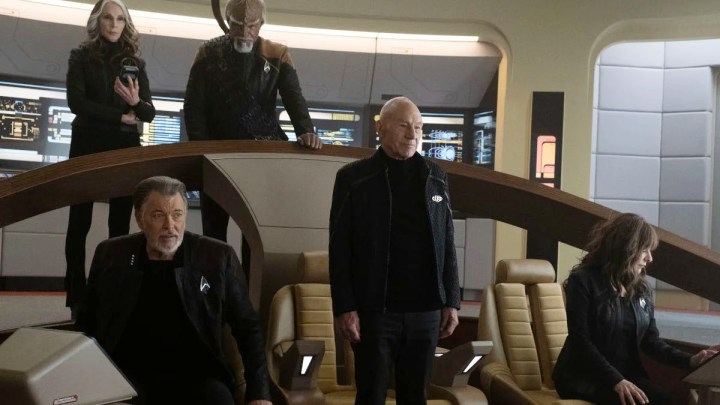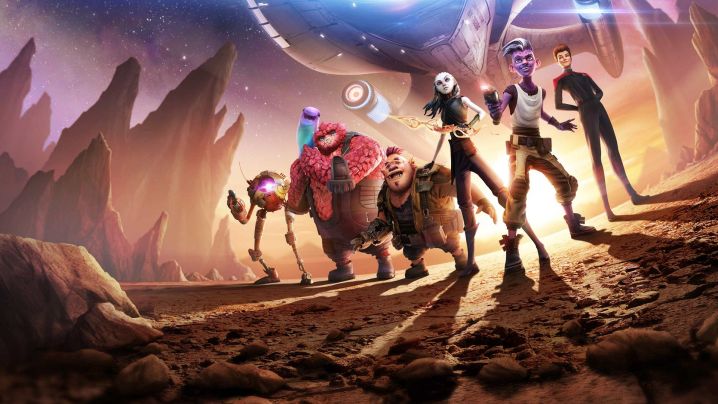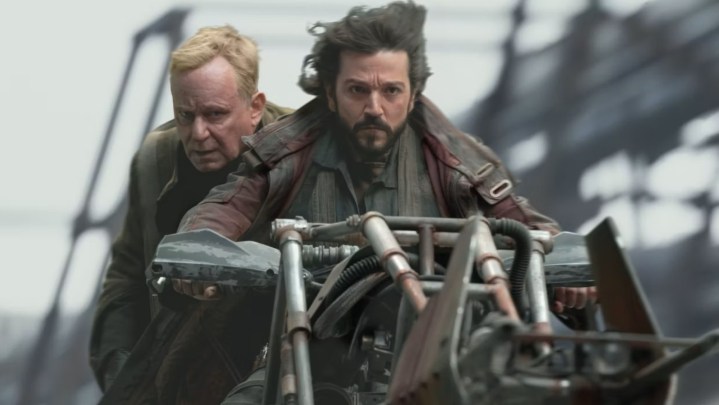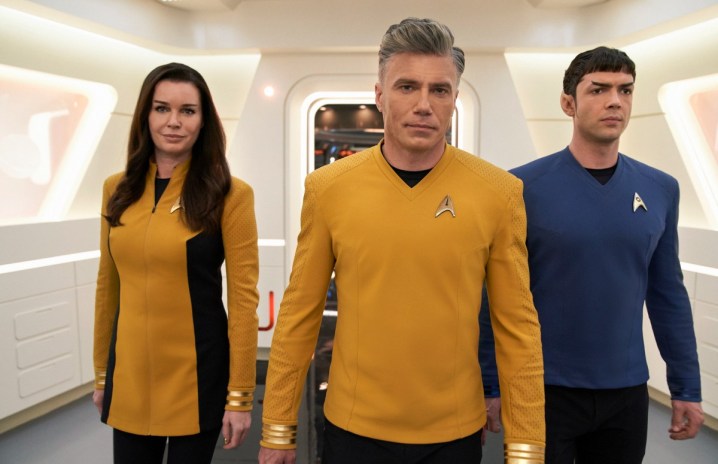For as long as both entities have existed, fans of science fiction and fantasy have debated the merits of Star Trek and Star Wars. But for most of the 45 years that the two franchises have overlapped, Star Trek and Star Wars haven’t actually had much in common, apart from their cosmic setting. Star Trek is an aspirational sci-fi series set in humanity’s future, while Star Wars is a bombastic fantasy adventure that takes place in a far-off galaxy. One has primarily lived on weekly television, while the other has broken big-screen box office numbers.
However, in recent years, both Star Trek and Star Wars have become tentpoles for their parent companies’ subscription streaming services, Paramount+ and Disney+, respectively, each pumping out a steady stream of content in an ever-widening array of formats. This has led them to encroach further into each other’s territory than ever before. Star Trek vs. Star Wars is no longer an apples-to-oranges comparison — they are directly competing products, sharing some of the same ambitions and struggling against the same environmental forces.
We will likely never settle on which space franchise is the greatest of all time, but we can take a moment to ask: Which is better right now?
Star Trek and Star Wars have both leaned heavily into fan service

Studios have become increasingly risk-averse during the streaming era, and that’s meant relying on recognizable brands with loyal fanbases who will remain subscribed to a service as long as there are new releases within their favorite fictional universe. However, this dependence has also left streamers at the mercy of those same fans, who can now use social media to converse with creators or even make demands. While this can lead to crowd-pleasing moments like the return of popular characters or the inclusion of fan-promoted memes back into the product, it can also create a feedback loop in which creators continue to serve audiences slight variations on whatever fans say they like rather than expanding their worlds or telling new stories.
Over the past two years, both Star Trek and Star Wars have released series that are representative of this shamelessly fan-oriented approach. In 2022, Paramount+ released the first season of Star Trek: Strange New Worlds, a prequel series set aboard the original USS Enterprise and starring Anson Mount as Captain Kirk’s predecessor Captain Christopher Pike. This series was prompted by a vocal fan campaign after legacy characters Pike, Mr. Spock, and Number One were featured in the second season of Star Trek: Discovery in 2019. A petition to give these characters their own spin-off received over 30,000 signatures, eventually leading to Strange New Worlds receiving a series order. Happily, the fans were right about this one, and Strange New Worlds has become more than just a nostalgic throwback to classic Trek, but exactly the shot in the arm the franchise needed. The series retains the episodic format of pre-streaming Trek series, but benefits from modern production values, a charming cast, and a sense of joy and wonder that the serialized Trek shows Discovery and Picard have yet to deliver.

The recent third season of Star Trek: Picard has also been a serious crowd-pleaser, reuniting the cast of Star Trek: The Next Generation for one last 10-hour adventure. Though certainly the most recursive and least imaginative new installment of Trek’s streaming era, it has been wildly popular among fans, well-received by critics, and is the first Trek series to make a dent into Nielsen’s weekly Top 10 streaming charts. A petition to launch a sequel series featuring Picard’s younger cast members has surpassed the one that demanded a spin-off for Pike’s Enterprise, with over 44,000 signatures to date. There is a vocal online contingent that wants to hand the keys to the franchise to this season’s showrunner, gushing Star Trek fanatic Terry Matalas.
The current state of the Star Wars Galaxy should be a warning against that particular future for Star Trek. While ascended fan and George Lucas apprentice Dave Filoni has produced some of the best Star Wars television, such as the animated Star Wars Rebels and the incredible final season of The Clone Wars, his insistence upon building every new series directly on the back of the last one has left the Star Wars galaxy feeling both smaller and more confusing than it has in decades. Characters’ stories weave between animated and live-action series, making each product harder to follow on its own. Important character beats for the main characters of The Mandalorian are resolved in The Book of Boba Fett. Ahsoka is a live-action spin-off for the popular Clone Wars character, but is also a sequel to Rebels, seeded in a number of Mandalorian episodes. Die-hard fans will have no trouble following this and delight in getting to see their favorite animated characters brought to life in live-action follow-ups, but this comes at the expense of what has always been Star Wars’ greatest advantage over Star Trek: accessibility.
Meanwhile, the desire to tickle fans’ nostalgia glands with returning characters from the franchise’s past has resulted in creative misfires like the most recent Star Wars feature film, The Rise of Skywalker, the underwhelming Obi-Wan Kenobi streaming series, and the ghoulish practice of digitally applying the faces of young Mark Hamill or the late Carrie Fisher onto new actors. These are indications that even the unstoppable forces of time and death will not dissuade Disney from recycling the most popular Star Wars elements ad infinitum. That way lies madness.
Point: Star Trek
The streaming era has let both franchises experiment

Prior to the streaming wars, Star Trek and Star Wars each had their own clearly defined lanes. Star Trek was weekly television that occasionally spun off into feature films, aimed at adults but also fostering a family audience; Star Wars was a film series that very rarely dabbled in TV, fun for all ages but plainly angling for a toy-buying audience. There had never been a Star Trek series specifically for kids (not even the short-lived 1970s Star Trek: The Animated Series), nor had there been a Star Wars release that was made solely for adults. Over the past two years, however, both franchises have set their sights on the other’s target audience, with encouraging results.
In 2021, Paramount+ and Nickelodeon debuted Star Trek: Prodigy, a 3D animated action-adventure series aimed at kids under 12. Sporting a cast of colorful alien teenagers and a decidedly Star Warsian tone, Prodigy explores the Star Trek Universe from the perspective of complete outsiders, making it a perfect on-ramp for a young new fan. Prodigy is like no other Star Trek show before it, and yet it is still essentially Star Trek — a show about curiosity, cooperation, communication, and tolerance — winning it the enthusiastic approval of many adult Trekkies. It’s also a lot of fun, the sort of show that could easily capture the same sort of audience that The Clone Wars garnered during its earliest, most kid-friendly seasons. Naturally, it has spawned a toy line and a tie-in video game but is unlikely to compete with Star Wars to become a merchandising juggernaut.

Conversely, 2022 saw the release of Andor, the first Star Wars offering that feels totally adult-targeted. While still not explicitly sexual or any more graphically violent than the feature films, Andor is a slow, dense, character-driven drama that would bore most kids to tears. It is, nevertheless, one of the best new shows on television, the sort of series that could ably compete with Succession or Better Call Saul in the acting, writing, and directing categories at next year’s Emmys. Even after the relatively gritty Rogue One: A Star Wars Story, to which Andor serves as a prequel, few fans predicted that a new Star Wars series would emerge that had so little interest in being commercial or toyetic.
And yet, its radical politics and revolutionary vigor are a perfect modern extrapolation of George Lucas’ original intent behind Star Wars, a film inspired by the Vietnam War in which the well-armed, well-funded government and military are the bad guys. It’s the side of Star Wars that was buried under mountains of merchandise as Lucas built his own Empire. Rival Star Trek has always been more overtly political, but with Andor, Star Wars has delivered an incisive dose of agitprop that would make Gene Roddenberry blush.
Point: Star Wars
The streaming bubble is forcing Star Trek and Star Wars to pump the brakes — and that’s good

As recently as 2022, both Disney and Paramount were betting the farm on streaming, spending unbelievable sums to pump out new installments of their most expensive franchises year-round. Disney+ debuted three live-action event series (The Book of Boba Fett, Obi-Wan Kenobi, Andor) and a set of animated shorts (Tales of the Jedi), totaling 23 weeks of new Star Wars content on the app. That same year, Star Trek hit critical mass, with a whopping 51 new episodes premiering on Paramount+ across all five of their ongoing series (Discovery, Picard, Lower Decks, Prodigy, and Strange New Worlds). As both services continue to hemorrhage money, it’s become clear that this breakneck pace of new content is not sustainable. Returning Disney CEO Bob Iger has ordered Lucasfilm and Marvel to slow the rollout of their planned streaming series in favor of more theatrical releases, and a trio of new Star Wars films was announced at 2023’s Star Wars Celebration event. Meanwhile at Paramount, Star Trek: Section 31, once planned as an ongoing series, is being retooled as a TV movie, with plans for new standalone Trek specials every two years. This strategy may allow Executive Producer Alex Kurtzman’s “Phase Two” of streaming Star Trek to explore new angles for the franchise without committing each of them to a pricey ten-episode season order.
While it’s true that a more conservative approach to either franchise could result in fewer big swings like Andor, it could also strike a blow against mediocrity. During the peak streaming era, mediocre installments like Picard season 2 or The Book of Boba Fett did little damage to their streamers’ credibility, as there was always another release right around the corner that might potentially make up for it. This pattern could continue uninterrupted for years, with a steady stream of good, fine, or outright bad Star Trek or Star Wars and very little great Star Trek or Star Wars. The less we get, the more valuable each new chapter will be, and the more invested everyone — from creators to fans — will be in its quality.

Individually, both upcoming franchises’ upcoming slates represent an exciting variety. Star Trek’s most uneven pillars, Discovery and Picard, are wrapping up, but Strange New Worlds, Prodigy, and the animated sitcom Lower Decks continue to go boldly in markedly different directions from each other (though Strange New Worlds and Lower Decks have a crossover episode coming up this year). Section 31 promises to be something totally new for Trek, a spy-fi adventure starring Oscar-winner Michelle Yeoh. A new series, Starfleet Academy, is also in early development. Across the divide, Star Wars has the hotly anticipated Ahsoka coming out this summer, with more Andor and The Mandalorian on deck. Star Wars: Visions, the exciting anthology of animated shorts created by studios around the world, is back for another season this year, and the trailer looks positively dazzling. Middling animated series The Bad Batch is coming to an end, seemingly putting the Clone Wars-adjacent era to bed for a while, while upcoming series The Acolyte and the three unnamed feature films will each take place in a different time periods, expanding a galaxy that has started to feel strangely claustrophobic.
Both of these upcoming slates look promising, but the sheer variety of announced Star Wars projects is simply too enticing to deny. However, whatever your individual preference, fans of space sci-fi will have plenty to argue over for years to come.
Point and overall winner: Star Wars
Editors' Recommendations
- Disney+ reveals the first trailer for Star Wars: Tales of the Empire
- Star Wars could’ve had Christopher Walken as Han Solo and Jodie Foster as Princess Leia
- Did Andor ruin Ahsoka, and maybe the entire Star Wars franchise, by being too good?
- Han Solo vs. Indiana Jones: Which one is Harrison Ford’s greatest role?
- How do I get into Star Trek? A guide to how to watch the beloved sci-fi franchise




